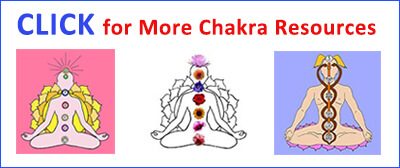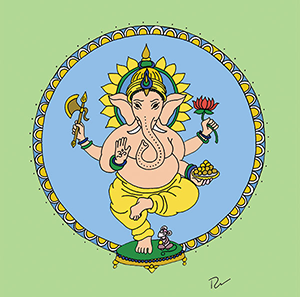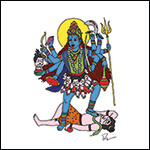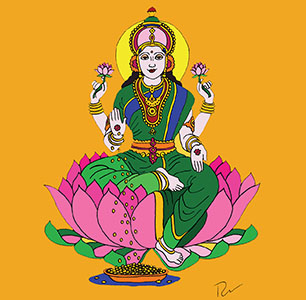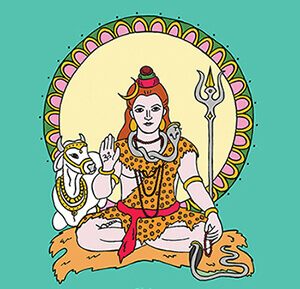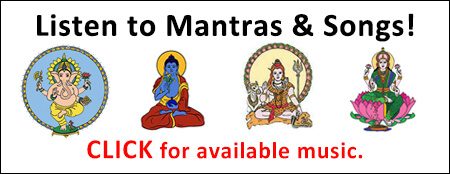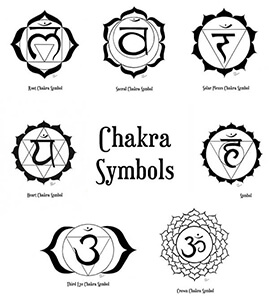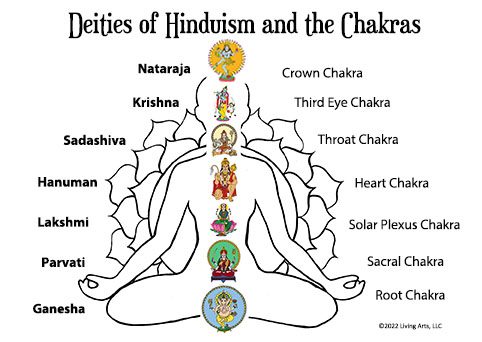
Download artwork on our FREE STUFF page!
Chakra Gods and Goddesses
Chakras are energy centers that exist at the subtle or non-physical level. There are chakra gods and goddesses associated with each of these energy centers in the Hindu tradition. In addition, each chakra is linked to psychological and emotional patterns.
Stories of the chakra gods and goddesses help to reveal these patterns and characteristics. Gaining an understanding the chakra gods and goddesses gives us insights into our own potential strengths and weaknesses in each of the 7 chakras.
Table of Contents
Share this page with a friend!
Purpose of Chakra Deities
Chakra deities embody the characteristics of their respective chakras. Therefore, understanding the chakra gods and goddesses helps to clarify the purpose of each chakra. Knowing more about the function of each chakra allows us to navigate a chosen spiritual path more efficiently.
Masculine and Feminine Deities
The chakra deities are generally paired as masculine and feminine beings. Each chakra also pertains to several aspects of life. For example, the root chakra is related to issues of security, shelter, food, safety, and grounding. As a result, multiple gods and goddesses are connected to each chakra.
Additional Aspects of the Chakras
The chakras and their respective deities are further connected to particular sounds, mantras, flowers, symbols, musical notes, essential oils and more. See all available Chakra Articles.
Chakra Deities Video Shorts
Root Chakra Gods and Goddesses
The gods Brahma, Indra, and Ganesha are associated with the root chakra. The feminine energy or goddess of the root chakra is known as Shakti or Kundalini. Extensive information about the root chakra can be found in the article Root Chakra Symbol Meaning.
Root Chakra Gods
The root chakra establishes a foundation for the rest of the chakras. The root chakra gods have significant parts to play in the cosmos: Brahma is the creative aspect of God, Indra is the god of the heavenly realm, and the elephant-headed god Ganesh or Ganesha helps us to overcome obstacles here on earth.
Root Chakra Goddesses
Shakti or the Goddess Kundalini is the energy that enlivens all of life. This is the unformed energy of the universe. The goddess Kundalini is a specific reference to the energy coiled at the root chakra. This energy is drawn upwards to the crown by spiritual practices.
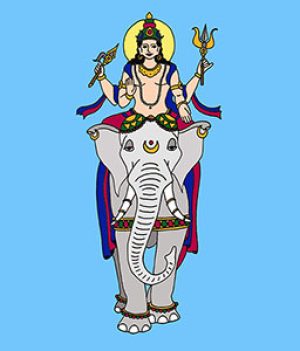
Download artwork on our FREE STUFF page!
Indra: Root Chakra God
The Hindu god Indra is associated with the root chakra as well as lighting, thunder, storms, rain, and rivers. Indra rides on an elephant, symbolizing compassion, intelligence, and ancient wisdom.
Elephant Symbolism
The elephant is a perfect metaphor for the root chakra: large and heavy, the elephant is a grounding influence to keep us tethered to the earth.
Indra’s Weapons
Indra holds a thunderbolt (vajra) in one hand and a trident (threefold spear) in the other. The thunderbolt cleaves through ignorance, dividing the real from the unreal. The trident represents three divine powers: will, knowledge, and action.
Trunk Symbolism
Sometimes the elephant that Indra rides has seven trunks. These elephants represent all seven of the major chakras or energy centers in the body.
Role of Indra
Indra is the king of the devas or divine beings. He has defeated an evil being (asura) named Vrita. This ensures the prosperity and happiness of mankind.
Savior of the Age
Some sources say that Indra is a title rather than a name. This means that every age has a new Indra or savior-like god.
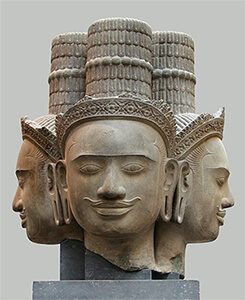
Learn more in the article on Root Chakra Meaning.
Brahma: Root Chakra God
Brahma is the Hindu god known as the Self-Born, the Lord of Speech, and the creator of the four Vedas. Brahma is the consort of Saraswati, the goddess of knowledge and wisdom. He is traditionally depicted with four faces and four arms.
Brahma’s Four Faces & Hands
Each of Brahma’s four faces point to a cardinal direction. His hands hold symbols of knowledge and creation: sacred texts, mala beads, a ladle, and a lotus.
Brahma’s Symbols
The sacred texts represent all forms of truth. The mala beads symbolize time. The ladle is used to feed a a sacrificial fire. The lotus is a symbol of enlightenment and eternity.
Brahma’s Images
Brahma is often depicted with a white beard and a sage-like expression. He sits on a lotus flower, dressed in white, red or pink. He has a swan or goose nearby upon which he can ride.
Download artwork on our FREE STUFF page!
Ganesha: Root Chakra God
Ganesha, a beloved elephant-headed Hindu god, is another prominent figure connected to the root or base chakra. Ganesha is often invoked at the beginning of an undertaking or an event. This makes sense: the root chakra must be aligned and purified for the energy to rise to the other chakras. Thus, mastering the root chakra is the beginning of the spiritual path.
Role of Ganesha
Ganesha is the patron of writers and learning. He is also known as Ganapati. In Hindu mythology, Ganesha is the son of the goddess Parvati and the god Shiva. Ganesha became a popular deity in the 2nd to 5th centuries AD. He is found in various traditions including Hinduism, Jainism, and Buddhism.
Ganesha as the Remover of Obstacles
Ganesha symbolism gives a glimpse into the stories and spiritual meaning of this well-known Hindu god. Accordingly, many of the symbols associated with Ganesha relate to his role as the remover of obstacles and the patron of new beginnings.
Ganesha’s Symbols
Ganesha’s symbols include many aspects of his appearance. His large belly holds the universe. His large ears create success through listening. His powerful trunk represents mastery and strength. Learn more about Ganesha’s history, mantras and symbolism in the video below or in the article called Ganesha Meaning.
Watch nearly 300 videos on our YouTube channel!
Kundalini: Root Chakra Goddess
The Sanskrit word “kundalini” means “coiled like a snake.” The snake is a common symbol of the kundalini, the energy curled at the base of the spine. As the kundalini moves upward, the energy flows through the seven major energy centers or chakras.
The Many Faces of the Goddess
The kundalini energy has been personified as a goddess in many different forms. The Goddess Kundalini is sometimes called Adi Parashakti. This literally means the “first and highest feminine energy.” Another goddess associated strongly with the kundalini energy is Durga. Learn more about Durga the Warrior Goddess.
Awakening the Kundalini
The awakening of the kundalini is viewed as one of the first steps on the spiritual path. Preliminary practices such as service, prayer, forgiveness, and purification are necessary to avoid becoming imbalanced as the kundalini energy surges.
Goddess Mantras
Goddess mantras are also effective in raising the Goddess Kundalini from her resting place. The goal of this goddess energy is to merge with the masculine energy in the upper chakras: throat, third eye and head. Click the images or links below to learn more about the Hindu goddesses and to listen to their respective mantras:
Learn more about mantras, Hindu deities, and chanting as a spiritual practice in Vocal Medicine: Transformation Through Sound by Kathleen Karlsen. Available as a PDF for instant download or as a paperback at Barnes & Noble Online or Amazon. Click below for more information.
Sacral Chakra Gods and Goddesses
The sacral chakra is associated with a number of gods and goddesses including Vishnu, the goddess Rakini and the goddess Parvati. There are others, but these are three of the main sacral chakra deities. Vishnu is an incarnation of Krishna. In this incarnation, he is the consort of Lakshmi, the goddess of wealth. More about the sacral chakra can be found at Sacral Chakra Symbol Meaning.
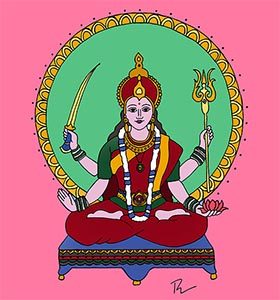
Download artwork on our FREE STUFF page!
Parvati: Sacral Chakra Goddess of Love
Parvati, also known as Uma, is the Hindu goddess of fertility, love and devotion as well as divine strength and power. She is the gentle and nurturing aspect of the goddess energy and the consort of Shiva.
Hindu Goddess Trinity
Parvati is part of a trinity of Hindu goddesses that also includes Lakshmi, the goddess of wealth; and Saraswati, the goddess of knowledge, music, and learning. Hear a mantra to Parvati and learn more about this goddess in the article Parvati Mantra.
Vishnu the Preserver: Sacral Chakra God
Vishnu is an incarnation of Krishna. In this incarnation, he is the consort of Lakshmi, the goddess of wealth. Vishnu is known as the preserver or the one who maintains the cosmos. He is one of the three persons of the Hindu trinity: Brahma (creator), Vishnu (preserver) and Shiva (destroyer).
Symbols of Vishnu
Vishnu has four arms. Each of his four hands hold a symbolic object. These objects are a lotus flower, mace, conch shell, and wheel. The lotus symbolizes purity, enlightenment and transcendence. The mace symbolizes mental and physical strength to destroy evil. The conch shell represents the creative power of sound. The wheel symbolizes cosmic law or karma.
Goddess Rakini: Sacral Chakra Hindu Goddess
Rakini is a goddess with two heads representing the duality between the external and internal worlds. This duality is also symbolized in light and dark, male and female, yin and yang, night and day, expansion and contraction and so forth.
Symbols of Rakini
Rakini is one of the eight female yogis in tantric texts. Like Vishnu, she has four arms holding four symbolic objects. These are a spear, a lotus, a drum and a battle axe. The spear represents a sharp mind. As noted above, the lotus symbolizes enlightenment. The drum links heaven and earth through sound. The battle axe is a lethal weapon for self-defense.
More Stories of the Chakra Deities
Watch nearly 300 videos on our YouTube channel!
Solar Plexus Chakra Gods and Goddesses
The solar plexus chakra is associated with the god Rudra, his consort Lakini, and the goddess Lakshmi. The solar plexus is the fire center, often symbolized by the color yellow or a sun-like image. Learn more about the Solar Plexus Chakra.
Rudra: Solar Plexus God in Hinduism
Rudra is a form of Shiva, usually depicted with a scarlet hue and three eyes. In this personification, Rudra is shown as an old man with a powerful bull as his vehicle. This is a form of Shiva that annihilates desire and wrong action.
Symbolism of the God Rudra
This powerful Hindu god is associated with both the solar plexus and the heart chakras. Rudra helps to dissolve worldly desires. He is covered with ashes, representing the final stage of matter when incinerated. This makes Rudra a symbol of immortality, dispelling all fear.
Aspects of Rudra
Rudra appears in the Vedas, ancient sacred scriptures. He has both destructive and beneficial aspects. Rudra is the divine archer, shooting arrows of disease and death. He is also a healer and source of remedies for ailments.
Download artwork on our FREE STUFF page!
Lakshmi: Solar Plexus Goddess of Wealth
Lakshmi is the goddess of wealth, fortune and prosperity. Her name is derived from a Sanskrit word meaning goal, aim or sign. In addition, Lakshmi is usually shown seated or standing on a lotus. The lotus symbolizes creation, beauty, harmony, diversity, stability, and support.
Solar Plexus Chakra of Peace
One of the benefits of maintaining equilibrium and peace in the solar plexus is the ability to acquire great wealth. Even more importantly, this master gives the ability to retain rather than disperse great wealth. Learn more about this goddess in the article Lakshmi Mantra to the Goddess of Wealth.
Lakini: Solar Plexus Chakra Goddess
Lakini is a benefactor goddess and the consort of Rudra. She is associated with the solar plexus, seat of the sun. This chakra encompasses the power of the emotions, intuition, and gut feelings. Lakini is depicted clothed in yellow like the sun. She drinks the nectar of the crown chakra.
Symbols of Lakini
Lakini has four arms. Three of her hands hold symbolic items (a thunderbolt, an arrow, and fire). The thunderbolt symbolizes an irresistible force of nature. The arrow represents to self (Atman or soul). Fire indicates an offering and transformation of the lower nature. Her fourth hand is held in the gesture or mudra of granting wishes and dispelling fears.
Watch nearly 300 videos on our YouTube channel!
Heart Chakra Gods and Goddesses
Mantras for the heart chakra emphasize the heart as the seat of love and devotion. The heart expresses charity, compassion, and kindness. The heart is a focus for beauty and culture. The heart brings the awareness of community and compassion for others. Learn more about the heart chakra in Heart Chakra Meaning.
Hanuman: Heart Chakra God of Hinduism
One of the main deities associated with the heart in Hinduism is Hanuman. Hanuman is the monkey-faced god who features prominently in the Hindu epic the Ramayana. Hanuman is known for loyalty and devotion. These specific qualities associate him with the heart chakra.
Qualities of Hanuman
The monkey-god Hanuman is the hero of epics and stories in Hinduism, Jainism and Buddhism. He is the ardent devotee of Lord Rama. Hanuman is the patron of martial arts, wrestling, and acrobatics. He is also the patron of meditation and scholarship.
Eastern Superhero
Hanuman is an Eastern superhero, perhaps akin to Superman, Spiderman or Batman in the West. He is a joyful figure, blessed with both agility and strength. Learn more about the superpowers of Hanuman and watch two mantra videos in the article Hanuman Mantra.
Watch nearly 300 videos on our YouTube channel!
Kuan Yin: Heart Chakra Goddess
The goddess Kuan Yin appears in East Indian sutras (scriptures) as well as in Tibetan Buddhism. In some sects, she is synonymous with the Buddha Avalokitesvara. She is associated with compassion, the primary quality of the heart. Kuan Yin also symbolizes the practice of mercy.
The Bodhisattva Vow
Kuan Yin is a bodhisattva. This means she has taken a vow to save all beings from suffering. She will forego full Buddhahood until all sentient beings are free. In this role, Kuan Yin comes as a Divine Mother to dispel all illusion.
Legend of Kuan Yin
A beautiful legend is that Kuan Yin was on the threshold of heaven when she paused and heard the anguished cries of the world. She then returned to earth to help all who are suffering. Kuan Yin’s full name is Kuan-shih-yin. This means “one who regards, looks on and hears the sounds of the world.”
Evolution of Kuan Yin
Kuan Yin originally had the name and form of Avalokitesvara, a male name and masculine being. Avalokitesvara means “the lord who sees or hears the sounds of the world.” Avalokitesvara was a Buddhist deity who evolved in Tibet into the female buddha Kuan Yin. Learn more about her history and mantras in Kuan Yin Healing Mantras.
Kuan Yin Legend and More Stories
Watch nearly 300 videos on our YouTube channel!
Throat Chakra Gods and Goddesses
The throat chakra is connected to creativity and self-expression as well as the actions of speaking, chanting, and singing. Mantras are an ideal tool for supporting the thyroid and related organs. One of the central Hindu gods associated with the throat chakra is Sadashiva. Other deities for the throat chakra are the Hindu god Ishvara and the goddess Saraswati.
Sadashiva: Throat Chakra God
Sadashiva is the highest form of Shiva, the Hindu god of dissolution. He is somewhat akin to the Holy Spirit in the Western tradition. Shiva expresses freedom, liberation and joy. There are many forms of Shiva as well as many consorts.
Learn more about Shiva and hear Shiva Mantras.
Five Faces of Sadshiva
Sadashiva is often depicted with five faces representing five emanations of God or the four directions plus upward movement. Other sources view Sadashiva’s five faces as symbolizing the forces of the universe: creation, preservation, destruction, obscuration and grace.
Additional Sadshiva Symbols
Sadashiva wears a tiger skin indicating his victory over animal instincts. The snake around his neck represents the endless cycle of birth and death. The trishula held in one hand is a three-in-one symbol representing the divine as a trinity.
Ishvara: Hindu Lord of the Throat Chakra
Ishvara is sometimes viewed as the embodiment of the Higher Self rather than a particular deity. In other schools of Hinduism, Ishvara is equivalent to Shiva. In other movements, Ishvara is synonymous with Brahma.
Meaning of Ishvara’s Name
The name “Ishvara” means “ruler of blessings” or “chief suitor.” In Buddhism, Ishvara is associated with Avalokitesvara, a bodhisattva that originated in a male form but is sometimes referred to as female (Isvari). This is a variation of Kuan Yin, also associated with the heart chakra.
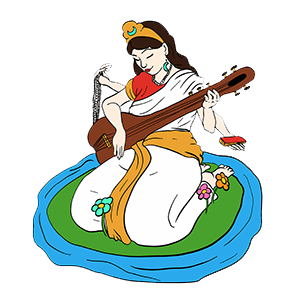
Saraswati: Throat Chakra Goddess
Saraswati is the Hindu goddess of wisdom, music and the arts. Her name means “the flowing one.” Her mantras often contain the seed syllable AIM, a feminine counterpart to the sound of OM. The bija syllable AIM is purported to strengthen the voice, clear the senses and open the lungs.
The Gift of Recitation
In ancient times, the ability to recite poetry and memorize Vedic scriptures was a highly honored skill. Saraswati is credited with granting this gift to her devotees. She is appropriately the goddess for the throat chakra since she governs speech, singing, and music.
Names of Saraswati
Goddesses often have multiple names reflecting all of their qualities and powers. Many have a thousand names! Saraswati is known by several lovely names including Saraswati Mata: Mother of Water and Lakes; Bharadi Mata: Mother of Wisdom and Science; and Bilvani Mata: Mother of the Woods. Learn more about Saraswati in the article Saraswati Mantra: Goddess of Music & Wisdom.
Third Eye Chakra Gods and Goddesses
The third eye is associated with several deities and combined forms of deities. For example, Shiva is often depicted as having three eyes because of his powerful development of this chakra. Other deities associated with the third eye include Vishnu and his incarnations as Krishna and Rama. The goddess Shakti is also associated with the third eye as the consort of Shiva.
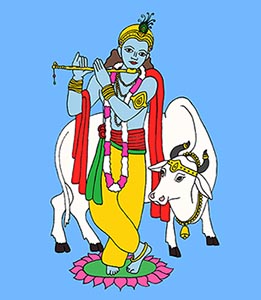
Krishna: Third Eye Chakra God
Krishna, one of the Hindu gods most closely associated with the third eye chakra, is the son of Devaki and her consort Vasudeva, king of the Chandravanshi clan. Devaki’s brother was Kansa, an evil tyrant. He was told that a child of Devaki would kill him, so he set out to murder the young Krishna.
Childhood of Krishna
For his own protection, Krishna was sent to live in the country with Nanda and his wife Yasoda. Krishna’s childhood was spent among their cow herds. This is the origin of Krishna’s childhood names, Gopala and Govinda. Learn more and listen to a Krishna Mantra.
Shiva the Destroyer: Third Eye Chakra
Shiva is one of the three persons of the Hindu trinity. There are many forms of Shiva, including the one associated with the throat chakra (Sadashiva) and Nataraja (associated with the crown chakra). Shiva is the aspect of God that strips the devotee of all illusions.
Symbolism of the Third Eye
To be stripped of illusions clears both spiritual and physical vision. Thus, Shiva is the god of the third eye. The third eye chakra is a sacred spot is sometimes marked on the forehead by the red dot known as the bindu. Shiva is said to possess enough power in his third eye to send out a deadly beam at will.
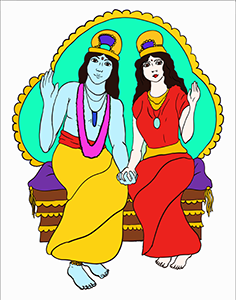
Rama the Healer: Third Eye Chakra
Rama is a god of protection, one of the nine incarnations of Vishnu. Rama is the most popular avatar of Vishnu, a paragon of virtue and chivalry. Rama is the central character in the Hindu epic the Ramayana. He is the consort of Sita. Rama, also known as Ram, and Sita have many adventures and trials together in this ancient story.
Eternal Lovers: Sita and Ram
Ram and Sita are sometimes viewed as symbolizing the unmanifest and the manifest minds or the pineal and pituitary glands. Sita and Ram are the ideal spouses. While Sita represents courage, dedication and purity, Ram (or Rama) represents truth, the soul and virtue. Learn more about Rama as well as his goddess Sita and listen to a Sita Ram Mantra.
Watch nearly 300 videos on our YouTube channel!
Shakti: Third Eye Chakra Goddess
The third eye chakra is symbolized by a central circle and a right and left lotus petal. The two petals of the 3rd eye symbol represent the ida and pingala (mystical spiritual channels). The petals also represent Shiva (a masculine deity) and Shakti (feminine form of God) on the left and right, respectively. In addition, the ida and pingala are sometimes viewed as the unconscious and conscious minds. Finally, the two petals represent the pineal and pituitary glands.
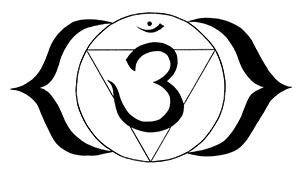
Balance of Shakti and Shiva
Shakti is the unformed energy of the universe much like the kundalini in the root chakra. However, the Goddess Shakti is uncontained and unbound where the Goddess Kundalini remains coiled at the base of the spine until awakened. It is Shiva or the masculine energy which provides a container or sets parameters for the expression of the Shakti energy. This is why the Goddess Shakti must be balanced by the intensity of Shiva.
Crown Chakra Hindu Gods and Goddesses
One of the presiding deities for the crown chakra is Shiva— often depicted in a dancing form known as Nataraja—Lord of the Dance. Shiva is one of the principal gods of Hinduism, part of the trinity composed of Brahma, Vishnu and Shiva. The goddess for the crown chakra is Chamunda, often interchanged with the goddesses Kali or Durga.
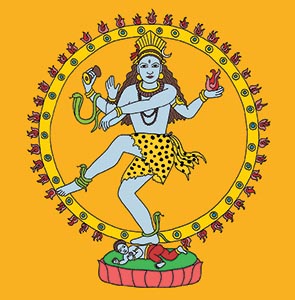
Nataraja: Crown Chakra Cosmic Dancer
Nataraja is the dancing form of Shiva, a joyful being spinning and dancing through creation. Nataraja represents the ecstatic state of enlightenment. Shiva is the destroyer of evil, akin to the Holy Spirit in the Christian trinity. Learn more about the sounds and seed syllables for the crown chakra in the article Chakra Sounds. Or listen to a Shiva Mantra.
Symbols of Nataraja
Shiva is often shown in association with serpents. In addition, he has a crescent moon in his hair as an adornment. The river Ganges is sometimes flowing from his hair or flowing nearby. As Nataraja, he shakes a drum known as a damaru. The snake around his neck represents the endless cycle of birth and death. The trishula or three-fold symbol held in one hand represents the divine as a trinity.
Chamunda: Crown Chakra Goddess
The Goddess Chamunda is a fearsome form of the goddess Chandi. She is the goddess of war, time, death and disasters. Chamunda may have originated as a tribal goddess and been assimilated into mainstream Hinduism at a later date. Chamunda is often viewed as interchangeable with the goddesses Kali and Durga.
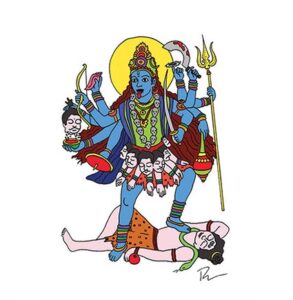
Download artwork on our FREE STUFF page!
Understanding the Goddess Kali
Kali is a more well-known version of this fierce goddess. She is an intimidating figure, brandishing multiple weapons with her many arms. Kali wears a skirt of severed arms and a gruesome garland of heads. These grisly body parts are symbolic of the demonic forces that she slays to protect her devotees. Learn more in Kali Mantra: Goddess of Time and Death.
Durga the Divine Mother
Durga is a principal form of the Divine Mother in Hinduism. She personifies the vibration of the fierce mother, moving into battle to protect her own and never simply for the sake of violence. The name Durga means a fort or a place that is difficult to overrun. This is appropriate for a goddess representing the crown chakra. Once the goddess energy has reached this level, the chances of being overcome with worldly desires or ambitions is relatively low. More in Durga Mantra & Stories of the Goddess.
Benefits of Chakra Gods and Goddesses
The stories of the gods and goddesses of Hinduism can generally be viewed as religious parables, legends, or mythology. In some cases, the chakra gods and goddesses are based on the lives of historical persons. They can also be seen as personifications of specific qualities. The gods and goddesses may exist at one or more levels: psychological, spiritual, mythological and historical.
Finding a Personal Deity
Perhaps the most significant aspect of relating to a chakra god or goddess is the sense of a personal relationship. Giving devotion to a specific form of the deity can reinforce those characteristics within ourselves. The personal connection also helps us to orient and navigate in an unseen realm.
Characteristics of Chakra Deities
The Hindu gods and goddesses are like us in many ways. For example, they are often grouped in families. They have complex relationships with other divine beings. They have recognizable personality traits, emphasizing particular attributes such as strength, beauty, love, wealth, or creativity.
Stories of the Gods & Goddesses
Every tradition has heroes and heroines as examples to emulate. In other cases, their biographies may be cautionary tales of pitfalls to avoid. This results in memorable stories about the exploits of the chakra gods and goddesses.
FREE download: Full set of the 7 chakra symbols.
Ways to Understand Chakra Deities
There are several ways to develop a deeper understanding of the Hindu deities. You can strengthen your own chakras through developing this connection. The following are some ideas and spiritual practices that can assist in this process:
- Study the stories of the chakra deities in Hinduism to understand the qualities that they possess. These could be yogic siddhis (powers) or admirable personal characteristics such as fearlessness, compassion or loyalty.
- Investigate the iconography or symbolism in depictions of one or more of the gods or goddesses for a chakra. Many gods and goddesses hold symbolic objects in their hands or use their hands in mudras or symbolic gestures.
- Meditate on an image or statue of the chakra deity. Deepen your connection to your own qualities and virtues embodied by that deity.
- Use mantras or chants related to the chosen chakra deity. Mantras help to activate the qualities of the deity within yourself.
More Chakra Resources
Click for Chakra Flowers Article
Chakras and Musical Notes: Chakras and musical notes have been paired in a number of ways. Learn about both Western and Eastern systems.
Chakra Names: Chakra names reveal the roles of the chakras in the body on psychological, spiritual and emotional levels. Includes explanations of English and Sanskrit chakra names.
Chakra Flowers: Chakra flowers offer unique symbolic meaning for each of the seven major chakras. Flowers are among the oldest spiritual symbols, revealing the meaning of each chakra.
Author Kathleen Karlsen
Kathleen Karlsen is a musician, artist, writer and speaker. She is the author of two books (Flower Symbols and Vocal Medicine) and over 200 articles. Kathleen, her husband Andrew, and their five children live in Bozeman, Montana. More about Kathleen Karlsen.
Chakra Gods and Goddesses Article Summary
This article covers the chakra gods and goddesses in the Hindu tradition. Pairing together the functions of the chakras and the personifications of the chakra energies helps to clarify the purpose of particular chakras. Each of the seven major energy centers are associated with one or more of the chakra gods and goddesses in the Hindu pantheon.

